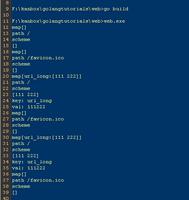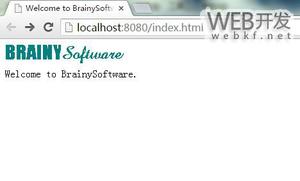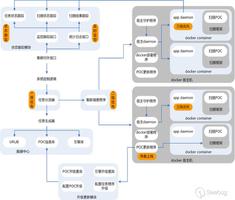Java 实现 web服务器的简单实例
Java 实现 web服务器的简单实例
实例代码:
import java.util.*;
// Chapter 8, Listing 3
public class WebServerDemo {
// Directory of HTML pages and other files
protected String docroot;
// Port number of web server
protected int port;
// Socket for the web server
protected ServerSocket ss;
// Handler for a HTTP request
class Handler extends Thread {
protected Socket socket;
protected PrintWriter pw;
protected BufferedOutputStream bos;
protected BufferedReader br;
protected File docroot;
public Handler(Socket _socket, String _docroot) throws Exception {
socket = _socket;
// Get the absolute directory of the filepath
docroot = new File(_docroot).getCanonicalFile();
}
public void run() {
try {
// Prepare our readers and writers
br = new BufferedReader(new InputStreamReader(
socket.getInputStream()));
bos = new BufferedOutputStream(socket.getOutputStream());
pw = new PrintWriter(new OutputStreamWriter(bos));
// Read HTTP request from user (hopefully GET /file...... )
String line = br.readLine();
// Shutdown any further input
socket.shutdownInput();
if (line == null) {
socket.close();
return;
}
if (line.toUpperCase().startsWith("GET")) {
// Eliminate any trailing ? data, such as for a CGI GET
// request
StringTokenizer tokens = new StringTokenizer(line, " ?");
tokens.nextToken();
String req = tokens.nextToken();
// If a path character / or / is not present, add it to the
// document root
// and then add the file request, to form a full filename
String name;
if (req.startsWith("/") || req.startsWith("//"))
name = this.docroot + req;
else
name = this.docroot + File.separator + req;
// Get absolute file path
File file = new File(name).getCanonicalFile();
// Check to see if request doesn't start with our document
// root ....
if (!file.getAbsolutePath().startsWith(
this.docroot.getAbsolutePath())) {
pw.println("HTTP/1.0 403 Forbidden");
pw.println();
}
// ... if it's missing .....
else if (!file.exists()) {
pw.println("HTTP/1.0 404 File Not Found");
pw.println();
}
// ... if it can't be read for security reasons ....
else if (!file.canRead()) {
pw.println("HTTP/1.0 403 Forbidden");
pw.println();
}
// ... if its actually a directory, and not a file ....
else if (file.isDirectory()) {
sendDir(bos, pw, file, req);
}
// ... or if it's really a file
else {
sendFile(bos, pw, file.getAbsolutePath());
}
}
// If not a GET request, the server will not support it
else {
pw.println("HTTP/1.0 501 Not Implemented");
pw.println();
}
pw.flush();
bos.flush();
} catch (Exception e) {
e.printStackTrace();
}
try {
socket.close();
} catch (Exception e) {
e.printStackTrace();
}
}
protected void sendFile(BufferedOutputStream bos, PrintWriter pw,
String filename) throws Exception {
try {
java.io.BufferedInputStream bis = new java.io.BufferedInputStream(
new FileInputStream(filename));
byte[] data = new byte[10 * 1024];
int read = bis.read(data);
pw.println("HTTP/1.0 200 Okay");
pw.println();
pw.flush();
bos.flush();
while (read != -1) {
bos.write(data, 0, read);
read = bis.read(data);
}
bos.flush();
} catch (Exception e) {
pw.flush();
bos.flush();
}
}
protected void sendDir(BufferedOutputStream bos, PrintWriter pw,
File dir, String req) throws Exception {
try {
pw.println("HTTP/1.0 200 Okay");
pw.println();
pw.flush();
pw.print("<html><head><title>Directory of ");
pw.print(req);
pw.print("</title></head><body><h1>Directory of ");
pw.print(req);
pw.println("</h1><table border=/"0/">");
File[] contents = dir.listFiles();
for (int i = 0; i < contents.length; i++) {
pw.print("<tr>");
pw.print("<td><a href="/" rel="external nofollow" rel="external nofollow" mce_href="/" rel="external nofollow" rel="external nofollow" "");
pw.print(req);
pw.print(contents[i].getName());
if (contents[i].isDirectory())
pw.print("/");
pw.print("/">");
if (contents[i].isDirectory())
pw.print("Dir -> ");
pw.print(contents[i].getName());
pw.print("</a></td>");
pw.println("</tr>");
}
pw.println("</table></body></html>");
pw.flush();
} catch (Exception e) {
pw.flush();
bos.flush();
}
}
}
// Check that a filepath has been specified and a port number
protected void parseParams(String[] args) throws Exception {
switch (args.length) {
case 1:
case 0:
System.err.println("Syntax: <jvm> " + this.getClass().getName()
+ " docroot port");
System.exit(0);
default:
this.docroot = args[0];
this.port = Integer.parseInt(args[1]);
break;
}
}
public WebServerDemo(String[] args) throws Exception {
System.out.println("Checking for paramters");
// Check for command line parameters
parseParams(args);
System.out.print("Starting web server...... ");
// Create a new server socket
this.ss = new ServerSocket(this.port);
System.out.println("OK");
for (;;) {
// Accept a new socket connection from our server socket
Socket accept = ss.accept();
// Start a new handler instance to process the request
new Handler(accept, docroot).start();
}
}
// Start an instance of the web server running
public static void main(String[] args) throws Exception {
WebServerDemo webServerDemo = new WebServerDemo(args);
}
}
感谢阅读,希望能帮助到大家,谢谢大家对本站的支持!
以上是 Java 实现 web服务器的简单实例 的全部内容, 来源链接: utcz.com/z/313850.html








